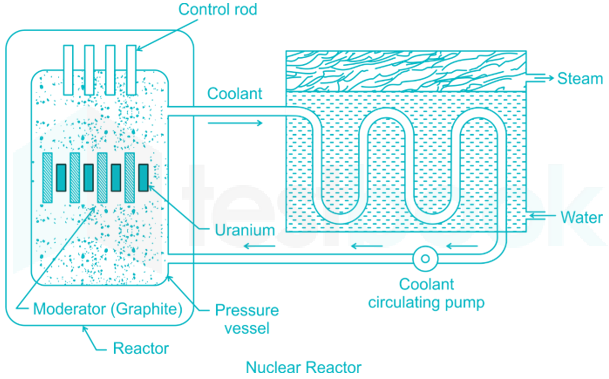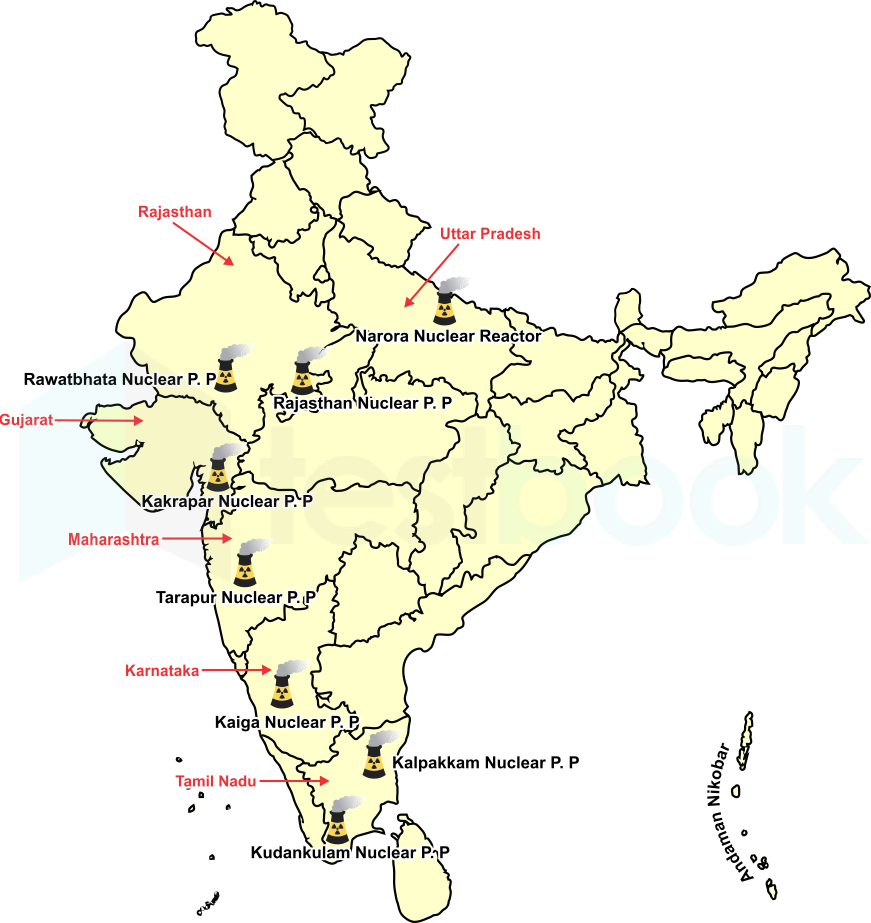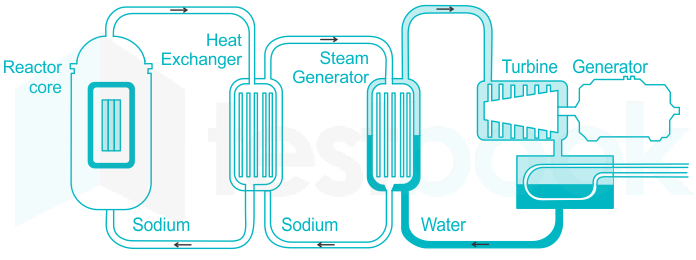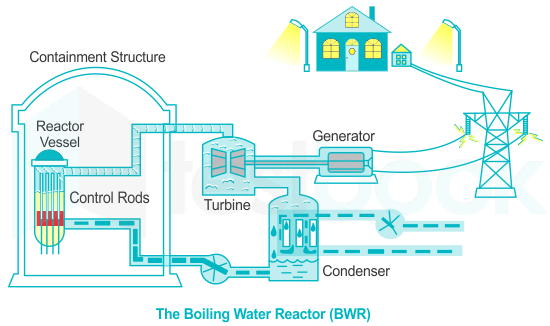1. In nuclear power station, moderator is used to,
A. absorb neutrons
B. reduce the speed of neutrons
C. accelerate the speed of neutrons
D. stop chain reactions
Answer: B. reduce the speed of neutrons
Explanation:
Nuclear reactor:

A. USA
B. India
C. Kazakhstan
D. Uzbekistan
E. None of the above/More than one of the above
Answer: C. Kazakhstan
Explanation:
3. Kakrapar Atomic Power Station is located in____
A. Tamil Nadu
B. Gujarat
C. Madhya Pradesh
D. Uttarakhand
Answer: B. Gujarat
Explanation:
The correct answer is Gujarat.
Nuclear Power Plants in IndiaAtomic power station State
4. The material used for the construction of control rod in a nuclear reactor is:
A. Copper
B. Cadmium
C. Graphite
D. Silicon
Answer: B. Cadmium
Explanation:

5. Which power plant requires highest initial cost and minimum cost of fuel transportation?
A. Diesel power plant
B. Steam power plant
C. Nuclear power plant
D. Hydro-electric power plant
Answer: C. Nuclear power plant
Explanation:
Advantages of Nuclear Power Plant:
If we compare Hydro Power Plant with Nuclear Power plants then we found that the initial cost of Hydro Power Plant is high, if we consider the cost of fuel transportation then we found that there is no fuel transportation cost applied to Hydro Power Plant because in Hydro Power Plant water is act as fuel.
Hence, according to the question, Nuclear Power Plant has the highest initial cost and minimum cost of fuel transportation.
Some Information:
Advantages of Hydro-electric power plant:
Disadvantages of Hydro-electric power plant:
6. The purpose of moderator in the reactor core of a nuclear power plant is to:
A. Reduce the neutron speed
B. Break uranium atoms
C. Shut down the reactor
D. Heat the coolant
Answer: A. Reduce the neutron speed
Explanation:

7. The first nuclear reactor was set up in India at______.
A. Rana Pratap Sagar
B. Bombay
C. Tarapur
D. Kalpakkam
Answer: B. Bombay
Explanation:
The correct answer is Bombay.
Important Notes:
8. A boiling water reactor uses which of the following as fuel?
A. U234
B. U235
C. Enriched uranium
D. Plutonium
Answer: C. Enriched uranium
Explanation:
Common uses of some Radioactive elements:
Elements VS Uses
Enriched uranium:
Boiling water reactor:
Explanation:
About Tarapur Atomic Power Station:

Nuclear Power Plant State of location Opened in
Nuclear power plant State Capacity
10. If K is the ratio of the rate of production of neutrons to the rate of loss of neutrons, the reactor is called a critical reactor, when
A. K = 0
B. 0 < K < 1
C. K = 1
D. K > 1
Answer: C. K = 1
Explanation:
Neutron Reproduction Factor (K) and Critical Size:
All the neutrons produced may not cause further fission. The neutrons may be lost due to:
Leakage from the system (or fissionable matter) and
Capture by impurities or non-fissionable uranium atoms.
Whether chain reaction once started will remain steady, increase or decrease depends on a parameter called the neutron reproduction factor (K).
Mathematically,
K=Rate of production of neutronsRate of loss of neutrons
11. Which of the following is NOT a coolant used for fast breeder reactor?
A. Carbon Dioxide
B. Oxygen
C. Liquid metal
D. Helium
Answer: B. Oxygen
Explanation:
i) Liquid metal (Na or NaK).
ii) Helium (He)
iii) carbon dioxide.

12. The main function of shielding in nuclear reactor is provide protection against:
A. α - rays
B. β - rays
C. γ - rays
D. None of these
Answer: C. γ - rays
Explanation:
Shielding of Nuclear Reactor:
A. absorb neutrons
B. reduce the speed of neutrons
C. accelerate the speed of neutrons
D. stop chain reactions
Answer: B. reduce the speed of neutrons
Explanation:
Nuclear reactor:
- It is a device in which a nuclear reaction is initiated, maintained, and controlled.
- It works on the principle of controlled chain reaction and provides energy at a constant rate.
- The moderator's function is to slow down the fast-moving secondary neutrons produced during the fission.
- The material of the moderator should be light and it should not absorb neutrons.
- Usually, heavy water, graphite, deuterium, and paraffin, etc. can act as moderators.
- These moderators are rich in protons. When fast-moving neutrons collide head-on with the protons of moderator substances, their energies are interchanged and thus the neutrons are slowed down.
- Such neutrons are called thermal neutrons which cause fission of U235 in the fuel.
A. USA
B. India
C. Kazakhstan
D. Uzbekistan
E. None of the above/More than one of the above
Answer: C. Kazakhstan
Explanation:
- The correct answer is Kazakhstan.
- For more than 50 years, Kazakhstan has been a major producer of uranium.
- Kazakhstan has 12% of the uranium deposits in the world.
- Output grew from 2022 to about 22,550 U tonnes per year between 2001 and 2013, making Kazakhstan the world's leading producer of uranium.
- It became the world's top producer of uranium in 2009, with approximately 28% of world supply.
- The volume is approximately 25,000 tU/yr.
- Production was 22,808 tU in 2019, which constituted 43% of the uranium in the world.
3. Kakrapar Atomic Power Station is located in____
A. Tamil Nadu
B. Gujarat
C. Madhya Pradesh
D. Uttarakhand
Answer: B. Gujarat
Explanation:
The correct answer is Gujarat.
- The 700-megawatt pressurized heavy water reactor of the Kakrapar Atomic Power Station in Gujarat is the first of 16 planned units that will help balance the grid against growing intermittent renewable generation.
- The reactors are the heart of an atomic power plant, where a controlled nuclear fission reaction takes place that produces heat, which is used to generate steam that then spins a turbine to create electricity.
- India's first 700 MWe (megawatt electric) unit, and the biggest indigenously developed variant of the Pressurised Heavy Water Reactor.
- PHWR is a nuclear power reactor, commonly using unenriched natural uranium as its fuel, that uses heavy water as its coolant and moderator.
- PHWRs have advanced safety features like:
- Steel lined inner containment.
- Passive decay heat removal system.
- Containment spray system.
- Hydrogen management system.
- PHWR technology started in India in the late 1960s with the construction of the first 220 MWe reactor, Rajasthan Atomic Power Station, RAPS-1 under the joint Indo-Canadian nuclear co-operation.
- The biggest reactor size of the indigenous design was the 540 MWe PHWR, two of which have been deployed in Tarapur, Maharashtra.
- India works to ramp up its existing nuclear power capacity of 6,780 MWe to 22,480 MWe by 2031.
- Kudankulam Nuclear Power Plant. Tamil Nadu
- Tarapur Nuclear Reactor. Maharashtra
- Rajasthan Atomic Power Plant. Rajasthan
- Kaiga Atomic Power Plant. Karnataka
- Kalapakkam Nuclear Power Plant. Tamil Nadu
- Narora Nuclear Reactor. Uttar Pradesh
- Kakarapar Atomic Power Plant. Gujarat
4. The material used for the construction of control rod in a nuclear reactor is:
A. Copper
B. Cadmium
C. Graphite
D. Silicon
Answer: B. Cadmium
Explanation:
- A nuclear reactor is a cylindrical stout pressure vessel and houses fuel rods of Uranium, moderator, and control rods
- The fuel rods constitute the fission material and release a huge amount of energy when bombarded with slow-moving neutrons
- The moderator consists of graphite rods that enclose the fuel rods. The moderator slows down the neutrons before they bombard the fuel rods.
- The control rods are of cadmium and are inserted into the reactor. Cadmium is a strong neutron absorber and thus regulates the supply of neutrons for fission.
5. Which power plant requires highest initial cost and minimum cost of fuel transportation?
A. Diesel power plant
B. Steam power plant
C. Nuclear power plant
D. Hydro-electric power plant
Answer: C. Nuclear power plant
Explanation:
Advantages of Nuclear Power Plant:
- The amount of fuel required is quite small. Therefore, there is the minimum cost of fuel transportation.
- A nuclear power plant requires less space as compared to any other type of the same size.
- It has low running charges as a small amount of fuel is used for producing bulk electrical energy.
- This type of plant is very economical for producing bulk electric power.
- It can be located near the load centres because it does not require large quantities of water and need not be near coal mines. Therefore, the cost of primary distribution is reduced.
- There are large deposits of nuclear fuels available all over the world. Therefore, such plants can ensure a continued supply of electrical energy for thousands of years.
- It ensures the reliability of operation.
- The fuel used is expensive and is difficult to recover.
- The initial cost of a nuclear plant is very high as compared to other types of plants.
- The erection and commissioning of the plant require greater technical knowledge.
- The fission by-products are generally radioactive and may cause a dangerous amount of radioactive pollution.
If we compare Hydro Power Plant with Nuclear Power plants then we found that the initial cost of Hydro Power Plant is high, if we consider the cost of fuel transportation then we found that there is no fuel transportation cost applied to Hydro Power Plant because in Hydro Power Plant water is act as fuel.
Hence, according to the question, Nuclear Power Plant has the highest initial cost and minimum cost of fuel transportation.
Some Information:
Advantages of Hydro-electric power plant:
- It has minimum or negligible fuel cost and there is no transportation cost on fuel because water act as fuel for the generation of electrical energy.
- It has very small running charges because water is the source of energy which is available free of cost.
- It is simple in construction and requires less maintenance.
- It takes very little time for starting.
- It is robust and has a longer life.
- In addition to the generation of electrical energy, they also help in irrigation and controlling floods.
Disadvantages of Hydro-electric power plant:
- It has a high initial cost because of the construction of the dam.
- There is uncertainty about the availability of a huge amount of water due to dependence on weather conditions.
- Skilled and experienced hands are required to build the plant.
- It requires a high cost of transmission lines as the plant is located in hilly areas that are quite away from the consumers.
6. The purpose of moderator in the reactor core of a nuclear power plant is to:
A. Reduce the neutron speed
B. Break uranium atoms
C. Shut down the reactor
D. Heat the coolant
Answer: A. Reduce the neutron speed
Explanation:
- A nuclear reactor is a cylindrical stout pressure vessel and houses fuel rods of Uranium, moderator, and control rods
- The fuel rods constitute the fission material and release a huge amount of energy when bombarded with slow-moving neutrons
- The moderator consists of graphite rods that enclose the fuel rods. The moderator slows down the neutrons before they bombard the fuel rods.
- The control rods are of cadmium and are inserted into the reactor. Cadmium is a strong neutron absorber and thus regulates the supply of neutrons for fission.
7. The first nuclear reactor was set up in India at______.
A. Rana Pratap Sagar
B. Bombay
C. Tarapur
D. Kalpakkam
Answer: B. Bombay
Explanation:
The correct answer is Bombay.
Important Notes:
- India's and Asia's first nuclear reactor, Apsara was inaugurated by Prime Minister Jawahar Lal Nehru on 20 January 1957.
- The reactor was designed by the Bhabha Atomic Research Center (BARC) and built with assistance from the United Kingdom, which also provided the initial fuel supply consisting of 80 per cent enriched uranium.
- Apsara is a light water swimming pool-type reactor with a maximum power output of one megawatt thermal (MWt).
- There are 7 more reactors are under construction with a combined generation capacity of 4,300 MW.
- Kudankulam reactor has the highest capacity of 2000 MW in India.
8. A boiling water reactor uses which of the following as fuel?
A. U234
B. U235
C. Enriched uranium
D. Plutonium
Answer: C. Enriched uranium
Explanation:
Common uses of some Radioactive elements:
Elements VS Uses
- Enriched Uranium ----Used in boiling water reactor
- Plutonium -----Used in nuclear weapons and nuclear power plants
- U234 -----Used in the making of nuclear weapons and nuclear fuels
- U235 ------Used in the nuclear industry
Enriched uranium:
- U-235 can start a nuclear reaction and sustain it. But that 0.7 percent in naturally occurring uranium isn’t enough to make a bomb or even a nuclear reactor for a power plant.
- A power plant requires uranium with 3 to 4% U-235 (this is known as low-enriched or reactor-grade uranium), and a bomb needs uranium with a whopping 90 percent U-235 (highly enriched uranium).
Boiling water reactor:
BWRs actually boil the water. Water is converted to steam, and then recycled back into the water by a part called the condenser, to be used again in the heat process. We can understand the overall working of the Boiling Water Reactor by the following diagram.

9. The first nuclear plant was built in India at:
A. Rana Pratap Sagar
B. Padghe
C. Kalpakkam
D. Tarapur
Answer: D. Tarapur

9. The first nuclear plant was built in India at:
A. Rana Pratap Sagar
B. Padghe
C. Kalpakkam
D. Tarapur
Answer: D. Tarapur
Explanation:
About Tarapur Atomic Power Station:
- Tarapur Atomic Power station is located in Tarapur, Maharashtra.
- It was the first commercial atomic power station of India commissioned on 28th October 1969.
- It was commissioned under 123 agreements signed between India, the United States, and International Atomic Energy Agency.
- The station is operated by the National power corporation of India.

Nuclear Power Plant State of location Opened in
- Kudankulam Tamil Nadu 1998
- Tarapore Maharashtra 1969
- Kaiga Karnataka 2000
- Narora Uttar Pradesh 1991
Nuclear power plant State Capacity
- Tarapur Nuclear power plant Maharashtra 1400 MW
- Rawatbhata Nuclear power plant Rajasthan 1180 MW
- Kudankulam Nuclear power plant Tamil Nadu 2000 MW
- Kaiga Nuclear power plant Karnataka 880 MW
10. If K is the ratio of the rate of production of neutrons to the rate of loss of neutrons, the reactor is called a critical reactor, when
A. K = 0
B. 0 < K < 1
C. K = 1
D. K > 1
Answer: C. K = 1
Explanation:
Neutron Reproduction Factor (K) and Critical Size:
All the neutrons produced may not cause further fission. The neutrons may be lost due to:
Leakage from the system (or fissionable matter) and
Capture by impurities or non-fissionable uranium atoms.
Whether chain reaction once started will remain steady, increase or decrease depends on a parameter called the neutron reproduction factor (K).
Mathematically,
K=Rate of production of neutronsRate of loss of neutrons
- If K = 1, the chain reaction will proceed steadily, i.e. it will be sustained. The size of the fissionable material corresponding to K = 1 is called Critical Size and the reactor is called a critical reactor.
- If K > 1, the rate of chain reaction keeps on increasing resulting in an explosion. The size of the fissionable material is greater than the critical size called supercritical size. This is the working principle of atomic bombs.
- If K < 1, the no. of fissions rapidly decreases and the process dies down.
11. Which of the following is NOT a coolant used for fast breeder reactor?
A. Carbon Dioxide
B. Oxygen
C. Liquid metal
D. Helium
Answer: B. Oxygen
Explanation:
- Breeder Reactor use in Nuclear Power Plant as a nuclear reactor that converts non-fissionable U238 into fissionable Plutonium-239, which can be used as a fuel in the production of nuclear energy.
- In this reactor, the core containing U235 is surrounded by a blanket (a layer of fertile material placed outside the core) of fertile material U238.
- In this reactor, no moderator is used. The fast-moving neutrons liberated due to the fission of U235 are absorbed by U238 which gets converted into fissionable material Pu239 which is capable of sustaining a chain reaction. Thus this reactor is important because it breeds fissionable material from fertile material U238 available in large quantities.
- Like sodium graphite nuclear reactor this reactor also uses two liquid metal coolant circuits. Liquid sodium is used as a primary coolant when circulated through the tubes of intermediate heat exchange transfers its heat to secondary coolant sodium-potassium alloy. The secondary coolant while flowing through the tubes of the steam generator transfers its heat to feed water.
- Fast breeder reactors are better than conventional reactors both from the point of view of safety and thermal efficiency.
i) Liquid metal (Na or NaK).
ii) Helium (He)
iii) carbon dioxide.

12. The main function of shielding in nuclear reactor is provide protection against:
A. α - rays
B. β - rays
C. γ - rays
D. None of these
Answer: C. γ - rays
Explanation:
Shielding of Nuclear Reactor:
- A nuclear reactor is a prolific source of potentially dangerous nuclear radiation. It is unavoidable since most of the radiation released originates from the fission process itself.
- In addition to the highly energetic neutrons and gamma rays that are emitted simultaneously with the fission event the fission fragments formed are highly radioactive nuclides that emit α and β radiations. The essential shielding problem is the attenuation of the penetrative fast neutrons and high-energy gamma rays that are released in the reactor core and reactor shield.
- The charged particle released, such as α and β radiation, and the heavily ionizing fission fragments are readily stopped within at most few centimeters of dense material so that the charged particle does not penetrate beyond the fuel elements and certainly not beyond the reactor core.
- The shielding of charged particle radiation is therefore a much less severe problem and shielding is done to protect against highly energetic neutrons and gamma rays.

